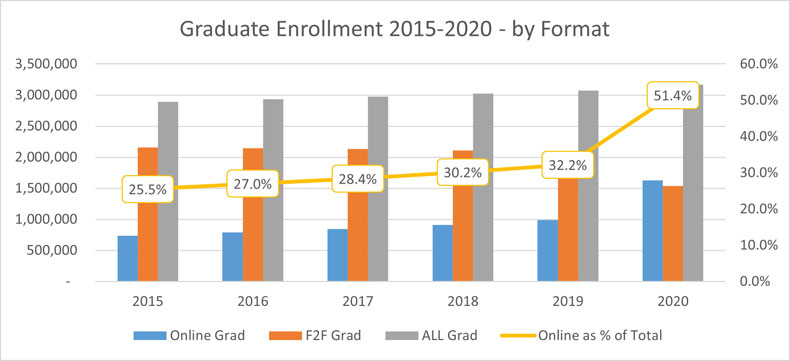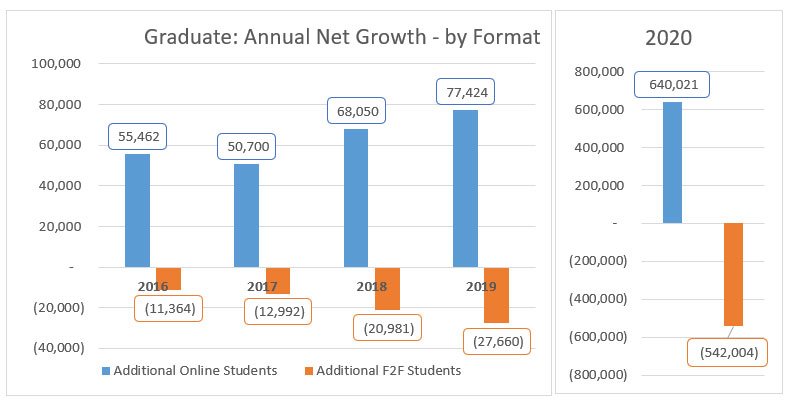enrollment
What Do 2020 Grad Level Enrollment Data Tell Us About the Future?
I have been looking forward to getting access to the 2020 IPEDS data for months. The completions data includes those graduating up to June 30, 2020—and therefore will help us understand just how much the pandemic impacted program performance. The fall 2020 enrollment snapshot will also help us understand just how much online education (or “all distance courses” in NCES parlance) grew. With this in mind, I pulled these data in order to provide a top-line summary.
Graduate Enrollment Patterns, 2015-20
Graduate online enrollment has been on the rise consistently over the last five years. In 2015 online students comprised 25.5 percent (737,732 students) of all graduate students. Four years later in 2019, 32.2 percent (989,359 students) were enrolled in online programs. That means that over that four-year period an additional 251,627 graduate students decided that online study was their preference. Fast forward one year and we see that 51.4 percent of all graduate students were reported to be taking “all distance courses.” This translates to 1.63 million students who were enrolled in online courses (I am specifically using the NCES verbiage here because not all of these students would consider themselves “online students.”) As I reviewed these data, I think I was more curious about the 49 percent who were not classified as “all distance.” My suspicion is that the bulk of these were enrolled in “one or more distance courses,” but that is a topic for a future blog.

What does this mean? In recent weeks we have been hosting face-to-face workshops with a lot of smart graduate and online enrollment leaders. As we have talked about these data, the “best minds in the business” are starting to think that while online enrollment is not likely to remain at the 2020 proportion, it is also not going to return to pre-pandemic levels. The thing to ask yourself is: what proportion of students who tried online will stay online? Again, our informal focus group discussions have pegged that at no less than half. That will put us at about 40 percent of graduate students being online in the very near future.
Annual net growth by format
My analysis of the data presented above made me curious about seeing what the annual growth in fully online students (NCES’s “enrolled in all distance courses”) looked like alongside growth of face-to-face classroom students. What I found was definitely NOT an endorsement for the expansion of F2F learning. In the tables below we portray Year-over-year net growth for online and classroom (F2F) students. In each year between 2016 and 2019, fully online enrollment grew between 55,462 and 77,424. In that same period there was NO growth in students enrolling in fully classroom (F2F) programs. In fact, each year fully classroom enrollment has contracted and each year that contraction has intensified. When I initially developed the table below, I included the 2020 numbers, but they dwarfed previous growth (and contraction) so much that the “bars” for the other years were not even visible. For this reason I have added them alongside the main table below. Note the difference in the scale. 2020 saw an increase of more than 640,000 students enrolled in all distance courses. 2021 data at this point is “anyone’s guess”, but if I had to hypothesize, I’d say we will see these patterns return to previous trends. I plan to compare that data with 2019 in order to have really understand long-term trends. Check back here in 12 months!

What does this mean? The first thing that occurred to me as I looked at these data graphically is that institutions that are putting most or all of their eggs into the classroom (F2F) basket are the least likely to benefit from recent trends in graduate enrollment growth. There are always exceptions to rules, but institutions need to really stretch themselves when they ask themselves “can this program be offered online?” Graduate students are rewarding both timeliness AND innovation in their selection of graduate programs. The Millennial and Gen Z generations have grown up in a world of choice and they will programmed to shop until they find what they want. This has translated to a mindset in their graduate program selection that has made “a match between personal interests and program content” the most important enrollment factor (according to our 2021 survey of 1,500 prospective graduate students). If such a student wants to learn online, they will search until they find an online program—whether or not a specific institution that they know thinks such a program can be offered online. This is a dramatic change from even a single generation before— mine (the often forgotten Gen X)—that was far more likely to sacrifice some of the details for the institution that we know and love.
Look for a similar blog that will profile the undergraduate data next month
I’ll be diving into the undergraduate data in the coming weeks. In the meantime, I invite you to talk with one of my colleagues about the details of online program demand in your region—and how we help institutions meet the specific demands of online students in their region. Contact us today for a complimentary consultation. We will prepare a regional data set for you and talk through the implications for your institution.
What are your best enrollment strategies for graduate students?
Our graduate enrollment experts can help you take a data-driven approach to optimizing your enrollment. Let’s talk about how you can exceed your goals and position your programs more competitively in the market.
